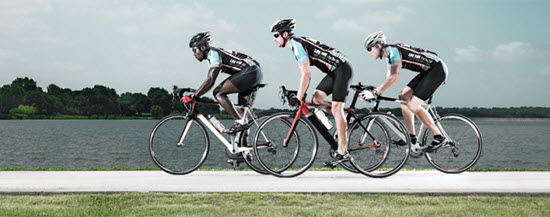By Team ICG® Master Trainer Jim Karanas
In the early days of indoor cycling, there was a problem. When bike resistance was low, the weighted flywheel connected to a fixed gear with a chain produced an unnatural degree of momentum. It permitted riders”™ legs to spin at cadences far above their natural ability.
This resulted in the infamous “bouncing” in the saddle, as well as potentially catapulting them over the handlebars if they were to suddenly stop pedaling. Then there were the as-yet-unknown, uninvestigated forces working on knees and hips.
So a ceiling was put on cadence. Everyone believed 120 rpm was fast enough. Some education bodies restricted it to 110 rpm. The reasons were obvious at the time. One look around a cycling class filled with “jumping beans”, or the surprised look on Superman”™s face as he went over the handlebars made it clear that we instructors needed to control cadence.
As IC evolved, cadence became less of a worry. Better control was taught from the start, and IC became safer. The 110-120 rpm ceiling has been challenged on occasion, but usually sticks. People don”™t typically ride at higher cadences, the logic goes, so why use them in cycling classes?
Is high cadence still unsafe? Do higher cadences offer training benefits in an authentic class, or general exercise benefits in a non-authentic class?
My opinion on safety is that high cadence is unsafe in some situations, but not in others. Cycling coaches are documented as recommending max-effort cadence drills up to 140-160 rpm. Arnie Baker”™s Smart Cycling is an example.
Arnie Baker”™s not alone. Cycling coaches don't have the same concerns IC instructors do about cadences above 110-120 rpm. They train athletes who are on road bikes on a track stand or a Computrainer. There”™s no weighted flywheel. There”™s no help on a real bike. It's all you. To spin at 140-160 rpm, you have to develop the necessary muscular composition and/or neuromuscular recruitment, or you can”™t do it.
Not so on a chain-driven indoor cycle. The weighted flywheel creates substantial inertia, which we”™ve spent decades teaching our students to control with technique and proper resistance. Chain-driven bikes create excess momentum and allow you to cheat on cadence training.
But belt-driven bikes can allow high-cadence training to become part of indoor cycling. The reduced momentum on a belt-driven bike makes it more like a real bike in terms of how hard you have to work to spin fast. I wrote about this in a previous post (“From Chain Junkie to Belt Convert”).
Should we create high-cadence trainings for our students if they”™re riding belt-driven bikes? The statement that we don't typically ride at those cadences and shouldn”™t train at them makes little sense to me.
High-cadence training, called spinning, can be defined as any cadence that exceeds a rider”™s preferred cadence, usually 120-160 rpm. These cadences are performed in lower gears, applying lighter pressure to the pedals with each stroke. Neuromuscular adaptation increases pedal stroke fluidity and reduces the force the leg muscles and joints must transmit for a given workload.
Higher cadences also allow the muscles to work aerobically. Less activation of type II muscle fibers delays the burning of carbohydrate stores. In a study by Ahlquist et al., a higher cadence resulted in less stimulation of fast-twitch muscle fibers. As fast fibers deplete their glycogen stores from slower, high-strength pedaling, they become less forceful. Additional muscle fibers must then be activated to maintain a given speed. The activation of a larger number of muscle cells leads to higher oxygen consumption rates and reduced economy.
With proper high-cadence training, pedaling rates of 80-100 rpm become easy for slow-twitch muscle fibers to handle. High-cadence training may also make type I muscle fibers faster and more fatigue-resistant. Then, even less glycogen is used within type II fibers because slow-twitch, type I fibers can handle the fast, low-force contractions.
To take advantage of these adaptations, cyclists use cadence drills. They train the neuromuscular system to increase coordination and efficiency at high pedaling rates and promote fatigue resistance in type I fibers at the same time. In the end, higher cadences preserve glycogen, leading to faster and more powerful finishes over a day of riding.
None of this makes a difference unless you believe in the effectiveness of high rpm. We do at ICG because the cycling world does. We train at much higher rpm than we promote in the industry because of the traditional 110-120 rpm ceiling and the stigma of going above it.
Also, some cyclists do pedal fast. Track cyclists do, as do riders on fixed-gear bikes going downhill — unless they”™re braking to slow their legs.
So high cadences have been validated in real cycling. What about non-authentic indoor cycling?
SoulCycle uses cadences over 120 rpm. They now produce their own bike, a chain drive. Is this safe? Maybe not. That's one reason we suggested that ACE research SoulCycle's training program. Would exceeding 120 rpm be safe on a belt-driven bike? We think so.
Still, the benefits I list above relate to cyclists. How does high-cadence benefit general membership? For one thing, it burns a ton of calories.
My view, and that of ICG, is it”™s time to allow faster spinning in certain situations. We”™ve advocated a belt drive for years, and I frequently train at cadences far in excess of 120 rpm on our bikes. Although our education still limits cadence to 120 rpm as a general rule, we”™re in discussion regarding high-intensity spinning.
When is high cadence okay? When the bike's momentum can be controlled and the instructor”™s training is of sufficient caliber to instruct correct pedaling efficiency.
Originally posted 2013-08-05 04:59:04.
- Spinning Our Wheels:Can’t We Go Faster? - February 24, 2024
- Still More on Motivation - January 1, 2024
- Differentiation:ICG® Academy Opens in San Francisco - December 23, 2023

